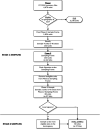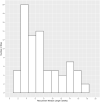Implementation of a sample design for a survey of program participants using time-location sampling
- PMID: 37195989
- PMCID: PMC10191336
- DOI: 10.1371/journal.pone.0285877
Implementation of a sample design for a survey of program participants using time-location sampling
Abstract
To assess the feeding practices and behaviors of women and young children participating in the Special Supplemental Nutrition Program for Women, Infants, and Children (WIC), USDA currently funds the longitudinal WIC Infant and Toddler Feeding Practices Study-2 (WIC ITFPS-2). In 2013, the study used time-location sampling (TLS) to enroll a cohort of infants who participated in WIC around birth. The children are subsequently followed across their first six years of life, regardless of their participation in WIC, with an additional follow-up at age nine years. A woman may enroll her child in WIC either during pregnancy or postpartum. For this study, a representative sample of infants enrolled in WIC was desired. Because the associations between WIC prenatal support and education and feeding practices and behaviors are substantively important to this study, the sample needed to include both women enrolling their children prenatally and women enrolling their children postnatally. For prenatal WIC enrollees, we attempted to complete a prenatal interview with the mother prior to the child's birth. This paper describes the TLS approach used and the challenges addressed in implementation of the sample design and selection for the WIC ITFPS-2. Our approach generated a probability sample (subject to site geographic and size exclusions) using a stratified, multistage design, but there were challenges at each stage of selection. First, a WIC site was selected, and then newly enrolled WIC participants were sampled within selected sites during predetermined recruitment windows based on the site's average flow of new WIC enrollees. We discuss issues faced, including overcoming incomplete lists of individual WIC sites and discrepancies between projected new WIC enrollment counts and actual flow of new WIC enrollments during the recruitment period.
Copyright: © 2023 Siegfried et al. This is an open access article distributed under the terms of the Creative Commons Attribution License, which permits unrestricted use, distribution, and reproduction in any medium, provided the original author and source are credited.
Conflict of interest statement
The authors have declared that no competing interests exist.
Figures



References
-
- Granovetter M. Network sampling: some first steps. AJS. 1976;81(6):1287–303.
-
- Heckathorn DD. Respondent-driven sampling: a new approach to the study of hidden populations. Soc Probl. 1997;44(2):174–99.
-
- Kalton G. Sampling flows of mobile human populations. Surv Methodol. 1991;17:183–94.
-
- McKenzie DJ, Mistiaen J. Surveying migrant households: a comparison of census-based, snowball and intercept point surveys. J R Stat Soc Ser A Stat Soc. 2009;172(2):339–360.
-
- Kalsbeek WD. Nomad sampling: an analytic study of alternative design strategies. American Statistical Association: Proceedings of the Section on Survey Research Methods. 1986;164–169.
Publication types
MeSH terms
LinkOut - more resources
Full Text Sources

